In This Post…
You have probably noticed that getting blog traffic is hard! Am I right? It definitely takes some work.
But, what if I told you that it doesn’t have to be that complicated. Will it take work? Yes. But, does it have to be this long, overwhelming, complicated slog that it is often thought to be? No, it does not.
The way most bloggers think about traffic, it seems almost impossible. Especially when you’re starting up from zero. We’re told we need to post a ton of blog posts, make videos, create a podcast, “engage” in social media, participate in groups, do blog commenting, guest posting, and…
HOLY CRAP!
That’s a lot of dang work. And, for many, it just doesn’t work.
So, is that really it? Is this just a matter of throwing more time at the problem? Churning out more content? Building up social profiles?
Well, I say no. In fact, that is an old and archaic way of thinking. Now, I’m not saying those things won’t work. However, we need to be real about the situation here.
I asked my readers what their biggest questions were when it came to blog traffic. Some of the answers included:
- How do you start off from zero? How do you build traffic from scratch?
- What is a good rate of growth in your blog traffic?
- Is there a certain traffic number that, once you reach it, it begins to grow organically?
- Should you focus on paid traffic or just free SEO traffic?
What I’m going to lay out in this guide is a definitive traffic plan for your blog. I’m going to lay out a bunch of traffic building strategies. But more importantly, I’m going to give you an order of effectiveness and my thoughts as to what to do – and when.
You do not have to do everything here – and I hope to make that clear.
Traffic tactics without understanding are useless. It’s noise. But, once we have that base of understanding of the WHY behind it, you’ll be able to evaluate all the numerous traffic tactics you may come across out there and make the right decision for you.
Why Less Visitors Can Actually Be Better
When we think of blog traffic, we usually think of number of visitors across our website. Those visitors are anonymous blips on a graph and… higher the better, right?
Wrong.
On the other end of that graph are REAL PEOPLE. Every visitor to your site is a flesh-and-blood person somewhere in the world. He or she has goals, problems, concerns, fears, feelings. And that person may be the kind of person who is the right fit for your blog (or business)… or perhaps not.
For example, I have a blog post on this blog that gets traffic every day which is about a cheap whiteboard option for the office. Which is great and all… except most people finding that post via search are not interested in blogging or online business. They show up on my traffic graphs, but for all intents and purposes, it is useless traffic.
So, the lesson here is to know WHO you wish to attract to your blog. What kind of person is the right fit for what you’re doing and wish to provide?
Then, we want to focus in on how to reach more of THOSE people. Not just anybody who may fog up a mirror.
I would much rather have 100 visitors who were a great fit for my business visit my blog… than 10,000 visitors who weren’t a great fit because they came expecting something different.
So, the first step of any traffic building is to determine WHO you wish to attract.
And then…
What kinds of things could you create that would attract that kind of person. Which leads us to…
Content Marketing Triangle (And Why This Is Important For Your Traffic)
That perfect ideal visitor to your blog is out there. In fact, there’s probably a whole army of them out there. And they’re looking for stuff. But, they just don’t know about you.
Our first item of business here is to meet them in a place of common reality. Most likely, you’re sitting there behind your blog thinking you have a lot to offer. On the flip side, your prospective visitor is out there with zero awareness that you even exist. That person will need to:
- Be reached in the first place. (Reach)
- Be met in a place of common reality or interest. (Relevance)
- Form a closer bond with you and your brand so that the affinity can increase and perhaps later they may become a customer. (Connection)
These are 3 specific points that, together, form what I call the Content Marketing Triangle.
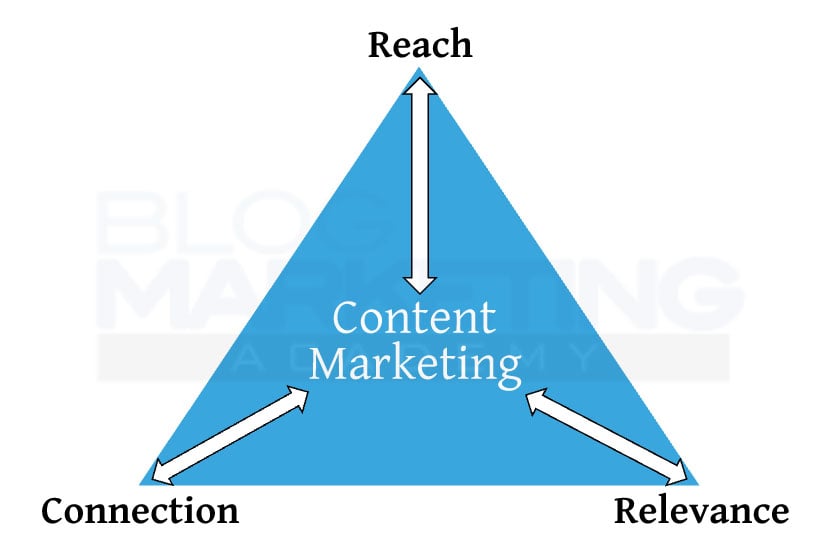
Reach is your ability to reach out and get people’s attention and talk to them. This could be by way of your blog, email list, social media, paid advertising, etc.
Relevance is the degree of match between the message you’re sharing and what that person needs or wants.
Connection is the degree of bonding between that person and you or your brand. It usually begins with some form of subscription (joining the email list or following on social media), then proceeds ultimately up to a repeat customer.
These 3 corners of the triangle go together and work in ratio to each other. The better you do in any one corner of the triangle, the more effective your traffic building will be.
It is the 3 corners of this content marketing triangle which will build your blog traffic and build your audience.
Kevin Kelly talked about finding 1,000 true fans and that, with those thousand people, you could essentially make a living. This notion is still true, so you should be looking to perform those 3 steps of connection with at least 1,000 people.
Now, you might think that reaching them in the first place is the most important step. But, that’s not true. In fact, that’s just mechanics. Because what is going to attract them to you in the first place is that common reality or interest.
So, we start with relevance.
Finding The Flypaper That Will Attract The Right Visitors To You

Finding this relevance starts with an understanding of the needs and wants of your prospective visitor. What are they really looking for?
Now, your first instinct is probably going to be something vague. Some “big picture” desire they have that we would throw out there and proclaim understanding. Like, I could say “my audience wants to grow their blog”. Yay. However, it is so vague that it will never resonate. I could go out there with some blog post like “How to grow your blog” and it will simply blend right into the scenery. No traffic will come from it.
So, we need to dive much deeper here and get much more specific about what these people REALLY want.
And you know what…
You’re not going to figure this out through speculation. You won’t figure it out by just dreaming it up, or by looking solely at what you feel like doing and then assuming they just want that.
No, you’re going to have to get out there and socialize. You’re going to need to interact with this target market. Look at the forums, the social media groups, conferences, bulletin boards, blogs, blog comments, Twitter accounts. You’ll need to ask questions and listen. You might even grab a few of them and have private Skype chats just to find out what they’re really WISHING they could find out there.
As you do all this (and it will be a process which is ongoing), you should maintain a big file for everything you find. Keep it in Evernote or whatever system you like to use. But, what you’re looking for are answers to questions like:
- What are they really looking to accomplish and what would they just LOVE to find online as the perfect dream solution to help them do it?
- What kinds of blog posts would make them feel like they hit the jackpot?
- What kinds of tools or shortcuts would they love to get access to?
- If they could dream up the perfect solution, what would it look like?
- What do they believe is holding them back, and what do they think a solution to that should look like?
It is knowing this kind of stuff which is going to provide you your fuel for content.
It is all about the relevance portion of our triangle. The more relevant we can make our content to the people we wish to reach, the more effective our reach will be.
Traffic Leverage: How To Maximize Your Reach

If you want traffic to not constantly be a struggle, then you need to be thinking in terms of building leverage. In other words, you want to build up those assets which will later make traffic much easier to get… on demand… and freely.
People merely coming by your blog and then leaving will raise your traffic stats, but it will not build you any leverage. It serves no long term benefit to you.
Traffic leverage is about building your own internal marketing assets that will act as a multiplier of all future marketing efforts you do, whether they be products or another blog post.
These assets make you less dependent out outside promotion.
The traffic leverage assets, in order of importance, are:
- Your email list.
- Your retargeting list
- Your social media accounts.
Simply put… every single item you release should be designed around these 3 things.
You don’t just write that killer blog post. No, you specifically tailor that blog post so that:
- They will feel compelled to opt-in for a tightly related lead magnet and thus become a subscriber on your list.
- Every single visitor to that blog post is pixeled and placed into a Facebook custom audience, Google remarketing list, etc.
- The content should be designed to be easily shared and thus not only refer viral traffic, but grow your social leverage.
No blog post should lack a strong call to action… most likely a lead magnet that will bring them into the email list. You also want to make sure your retargeting pixel is installed.
Now, this brings me to an equation I want you to never forget…
The 80/20 Traffic Formula (And Most Bloggers Do It Backwards)
Most bloggers just churn content. They just chuck it out there in an endless assembly line. It gets a little spike in blog traffic (maybe) then it goes off into the archives.
That’s a waste and a sure-fire formula to overworking yourself.
Most bloggers spend 80% of their time churning out content and only 20% (or less) thinking about marketing and promotion.

I want you to flip that around. Spend maybe 20% of your time on new content and the other 80% on promotion and building your business.
Now, how can you pull that off?
It means less blogging, for sure. But what it will mean is that each blog post you create is going to take more time, have more thought put into it, and be designed such that once it is released it will build your leverage. You want to take that time to craft the “perfect” blog post.
And, then you’re going to promote your new post. In fact, you’ll spend more time promoting it than you did creating it.
You can forget all of those useless conversations about posting frequencies. Those people are working too hard. And, more often than not, they’re not building their businesses.
So, 20% of your time on producing truly EFFECTIVE content… then you spend the other 80% on building your business.
And, no, we’re not talking about banner ads and crap like that. A real business is your true leverage. A real business will, quite literally, fuel your growth and your blog traffic.
Monetization and traffic are not a chicken and egg scenario, as most bloggers think.
You can see in our blog monetization business model how they work together hand-in-hand and how monetization fuels traffic and vice versa.
The Content Funnel (How To Make One Post Do A Ton Of Work For You)
So, we’re clearly not thinking about our blog content in terms of volume. We’re thinking about effectiveness. That will mean less blog posts, but the posts you DO create will serve a long term purpose.
Here at the Academy, we’re all about being strategic. If you’re being strategic with your content, then you treat your content as the top of a funnel. And that content is set up in such a way as to draw people into the funnel and ultimately lead them somewhere.
So, each blog post you release will serve a function in a content funnel. It will look something like this:
- Person arrives on this awesome blog post you’ve created. The value and relevancy of that post should be immediately relevant to the right person. People for whom it isn’t right for should bounce.
- Person is invited to take the next step or download a relevant shortcut, guide, checklist, tool… something like that. But, of course, that download will be a lead magnet and you will ask them to opt in for it. As part of the blog post.
- The person is also silently added to your retargeting list.
- The person is granted every chance to share the content with multi-media and network appropriate material. For example, if they share on Facebook, the post is formatted to appear in a way which will attract clicks. You could include a relevant infographic for sharing on Pinterest. You could embed quote cards for use on Twitter or Pinterest, with buttons right within the post to fuel retweets and shares.
- If the person doesn’t opt-in, they can be circled back via retargeting.
- If the person does opt-in, they’re brought further into your circle and the relationship builds.
- If you have a precisely relevant offer, you can present it to them after the opt-in and potentially turn them into a customer right away.
You set this up and every piece of blog content you publish has a long-term reason to exist.
Spending 80% of your time promoting it rather than creating it will then make perfect sense. Because that post builds leverage. It builds your business. It builds your list. And it will for some time.
Plus, treat it like a Redwood Post and it’ll serve as a long term asset.
You want marketing efficiency with your blog? This is it.
Making Traffic As Predictable As A Bowl of Rice
I first heard this analogy from Ryan Deiss at a Traffic & Conversion Summit and I thought it was a great analogy.
When you want a bowl of rice, what do you do? Do you buy land, prep the land, grow it over multiple months, pick it, clean it, boil it then put it in a bowl? This is a long LONG process that, yes, will result in a bowl of rice.
Or you could do what the rest of us do and go buy a box of Uncle Ben’s. 5 minutes and you have the rice you want.

Difference is… with one option you grew that rice from scratch the slow way. The other one, you just went to the store and bought it like the commodity it is.
Traffic is like rice. It is a commodity. Stores are selling it and those stores are known by names like Facebook, Google, Pinterest, Twitter, Taboola, etc.
What we have here is the difference between organic and inorganic traffic. Quite literally. Organic traffic meaning you’re growing it “by hand”, and inorganic traffic meaning you just acquired it.
And, it is a whole lot easier simply going to the traffic store and buying yourself some traffic! 🙂 It even comes with gift wrapping. 😉
Plus, when you buy traffic, you can specifically target the kinds of people you WANT for your blog. You can control who sees it and where they go. It is so much easier.
But, don’t fret. I’m not telling you that the answer to your blog traffic is simply to throw money at it. That’s not strategic and we’re all about strategy around here.
So, how do we make visits to the traffic store without wasting money?
How To Start Your Blog Traffic From Zero (The Predictable Way)
When the content that you publish is specifically tailored to be a long-term asset for you, then the easiest and most predictable way to get traffic to that post is to go to the traffic store and buy it.
This “primes the pump” and allows you to start the machine rolling without being dependent on lady luck or other outside influence to get the ball rolling. Then, as the pump begins moving and you begin building those leverageable assets, you can later decide whether you want to disable the paid ads and let your blog coast organically or whether you’d like to continue with those ads.
From my experience, once you get one of these funnels really working well, you won’t want to stop advertising. 🙂
This alleviates the chicken and egg scenario that building a blog from scratch can often feel like.
Starting from zero is the worst. Often, it makes you reliant on “big names” in your market to give you the jump start. This is where guest posting usually comes in. But, it isn’t necessary. You don’t need anybody’s approval, permission or good graces to run a Facebook ad, a Google ad, or any other kind of ad. You just do it.
And over time, this adds energy to your business. You’re building those assets like your email list, your social profiles, your retargeting list.
Before long, you don’t need paid traffic anymore. You own your own self-powering media empire and you can generate traffic on demand on your own terms.
Traffic is no longer a problem.
Now, are you put off by the fact that this costs money?
Well, let me ask you something…
Have you ever heard of a business which had zero startup costs? Probably not. Seems like when people get onto the internet all the normal rules and expectations of business go out the window. Businesses cost a little something to build. That’s just reality.
But, here’s the good news…
First, this type of thing is FAR cheaper than any “real world” offline business would cost to start. Like, a LOT cheaper. The costs of your paid traffic can be just a few bucks per day. In some markets, you could do it as for as little as a dollar per day.
Secondly, the way you make this pay off is (1) to have the leverage builders built into the process, and (2) to have some kind of offer that people can buy in order to make back some or all of that money.
You want some more good news?
You don’t even have to have built a product yet. You can create one out of “thin air”. In fact, it’s a damn good idea to do exactly that.
I firmly believe that monetization isn’t something you do after you have an audience. You do it as a fundamental component of building your audience.
Monetization doesn’t come after the audience is built. It is a fundamental part of building it.
Real Case Study: Starting Up A Blog From Scratch
Awhile back, I started up a hobby blog about RVs. RV camping is something I really enjoy and do a lot of. But, after years of having an established blog, I was newly in a position of starting up a brand new one from scratch.
What to do?
Well, I practice what I preach. 🙂 I created a redwood post specifically designed to provide a lot of value to people interested in RVs. I chose to do a blog post to present an inspection checklist to people who were evaluating used motorhomes to purchase. My content upgrade for the post was to opt-in and download a printable PDF checklist of essentially the exact same material which was in the blog post. The benefit to them was that they can print off the checklist and have it on hand when they’re out on location inspecting a motorhome.
I budgeted $5/day and I ran this ad:
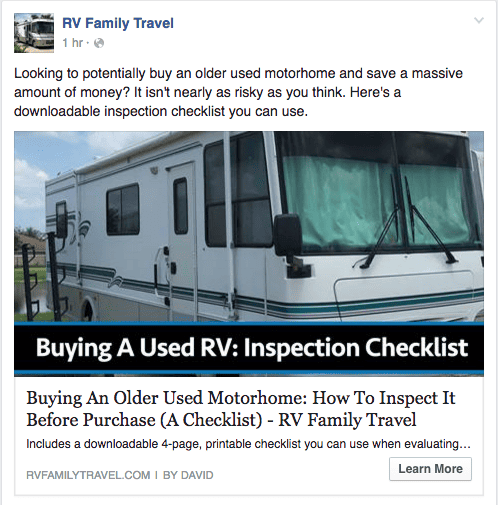
This was an ad which pointed directly to the blog post. Essentially, the ad is no different than what most of us do on Facebook every day: Share great content.
The results? I was able to drive readers to this post for 10 cents per click. My opt-in rate on the post came in at 12.6%. Ultimately, in about 4 months, I built an email list of 848 subscribers, all on the back of this one blog post. The Facebook page for this blog gained over 500 fans. I get people sharing this post organically all the time, too.

So, on the back of one blog post that had the proper leverage builders on it – and me amplifying that post directly into the right markets using paid traffic, I was able to build an email list of over 800 people, 500+ Facebook fans… and it just keeps on going.
What’s even better is that, whenever I email this list with a new blog post, I routinely see open rates over 40% and click-through’s around 12%.
I’m building in my own internal traffic sources. Before long, this little hobby RV blog is going to have more ability to command attention than many of the other blogs in the RV niche. And now, I can publish new content and get traffic to it whenever I want.
Now, I don’t hold these numbers up as a benchmark. After all, all markets are different. But, the process and methods are the same.
Traffic Building Methods: Different Strategies For Different Phases
So far, most of what we’ve discussed has to do with effective traffic generation if you’re starting from scratch.
See, in the beginning, you have no leverage. For that reason, most of the standard traffic techniques won’t work for you yet. You could make the most awesome content in the world and it will barely move the needle for you because you don’t have that built-in leverage yet.
When you’re first starting out, you need to focus on:
- Paid advertising (observing everything I discussed above).
- Personal outreach
- Podcasting & Interviewing (with you being the guest, preferably)
- Guest blogging (more on this below)
These 4 methods are the most leveraged ways to start off from scratch, and listed in the order of effectiveness.
Once you leave those 4 methods, you get into those traffic strategies that are much less efficient unless you already have some kind of audience in place. They’re not good “start from scratch” strategies.
As you build more leverage, the following traffic methods can be effective (to varying degrees):
- Social media & forum marketing
- Video marketing
- Submitting to social bookmarking sites and blog directories
- On page SEO
- Blog commenting
- Press releases
- Podcasting (without guests)
It just so happens that these kinds of traffic methods are the ones most often used by new blog owners. However, the growth from them is usually quite slow. Sometimes even stagnant. And that’s because they’re very inefficient.
A good analogy would be the gears of a car. If you’ve ever driven a stick shift, you know that trying to get the car moving in high gear can stall the car. To start from scratch, you need to use first gear. Traffic techniques are similar. Some are “high gear” strategies whereas others can be good low gear strategies.
[clickToTweet tweet=”In a car, there are low gears for starting and high gears for speed. For blog traffic, there are also good low-gear strategies for starting out… and others better once you have momentum.” quote=”In a car, there are low gears for starting and high gears for speed. For blog traffic, there are also good low-gear strategies for starting out… and others better once you have momentum.”]
Top Free Traffic Strategies (And Whether They Work Or Not)
Let’s discuss the relative effectiveness of the various ways of generating traffic the free way.
Guest Posting
The thing about guest posting is that it CAN be quite effective, however the way many people do it usually falls flat. Most people try guest posting just because they heard it works. But, just throwing posts up against the wall isn’t going to move the needle here.
To make guest posting work starts with keeping your eye on the right target. Remember up above where I discussed building leverage? And I ranked your email list as, by far, the most important component. So, THAT’S the real target of your guest posts.
Not comments, not views, nope.
Email subscribers.
So, to make it work, you first need to pick the right target blog. A blog which is active, has an engaged audience, and is active on social. You also need to knock it out of the park with your guest post so that it truly stands out in the context of the blog it is published on. Your post needs to have actual calls to action throughout the post… not just a link to your blog at the bottom. Nobody cares about those links at the bottom. They DO care about relevant high-value things inside the post itself.
Provide actionable calls to actions inside your guest post. To what? A landing page with your call to action to opt-in for whatever they were enticed with. Don’t link to your homepage. That’s an utter waste of time. Link to a squeeze page.
Some blogs might not allow you to link to your own stuff within the post. If that’s the case, just make a judgement as to whether it is still worth it for you. If you proceed, still ensure that the links in your author bio are actionable and not simply links to your homepage.
Lastly, I would have several solid redwood posts published on your blog by the time you attempt any guest posting. You want to impress them so much with your guest post that they ask, “Who is this person?” Then, when they visit your blog, you’ll impress them even further with our awesomeness. 🙂 And all of it optimized per your content funnel.
Podcasting

Podcasting can also be a good traffic generation technique. However, like most things, your results will depend on how you do it.
First off, never forget that pitching yourself as an interview guest on already established podcasts can be an effective strategy. Interview-driven podcasts are always on the lookout for guests. If you can show you’ll provide real value to the listeners of that show, the host will almost always say yes.
If you appear on a podcast as a guest, treat it like a guest post. In other words, have a landing page and a call to action ready for that podcast. Don’t just link them to your homepage. It’s easy to get lazy and show up unprepared to promote yourself. I’ve done it, too. But, it doesn’t give you the full effect that may otherwise come from your appearance on that show.
Next, let’s look at you producing your own podcast…
An interview-driven podcast can be a good strategy to build up traffic and your brand. The idea is to get your guests to help promote the show for you. Now, if you go into this without any unique selling proposition, it can fall flat. It isn’t your guest which make the show interesting. You have to have a strong USP.
Podcasting is a lot of work. They can be hard to start from scratch, although they CAN be effective.
If you’re first starting out and are looking to build up traffic, I’d recommend you start off pitching yourself as a guest on existing shows. That’s higher leverage. Starting up your own podcast (if you choose to do it) is a long term project not to be taken lightly.
Video Blogging
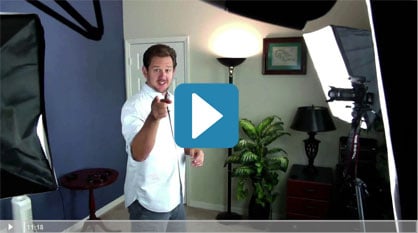
The thing about video blogging is that views and channel subscribers are all well and good… but neither grows your business. So, once again, we come back to the idea of building leverage. You need to be building that email list.
Video blogging is great for brand building. To build leverage, though, you need to have a deeper strategy than just making a bunch of videos. This would include:
- Putting calls to action in videos, where appropriate.
- Building pixeled retargeting audiences of people who viewed your videos.
Once again, think about your content funnel. Each video you put out there should be the top of a funnel in some way. How does that work?
- If the video is content heavy and very topical, put a call to action in the video to download a content upgrade. When they click, they go to a landing page where they can opt-in and that gets them into the funnel.
- If the video is more of a branding play and doesn’t lend itself directly to a lead magnet, then they’re still pixeled and added to a retargeting audience. You then have the ability to position more targeted videos in front of them which can then lead into a funnel. You can even place links to related videos into a more generic video, where those other videos are more direct leads into the funnel.
The point is, every video should have a strategy. A reason to be there. Raw views alone aren’t going to move the needle.
Youtube and Facebook are, by far, the most effective places to place your videos f0r marketing purposes.
Blog Commenting
This strategy used to be more effective. Today, it is ridden by spammers and bots and is generally a huge waste of time.
Surely, comment on blogs if you have something to say or ask. But, to do it just as a traffic technique? Nah.
You can use it to get onto the radar of an influential blogger and thus perhaps open doors to a guest post. But, hoping those backlinks on your comments lead to traffic? Hehe… you’ll be waiting for a long time. 🙂
Creating Viral Posts
We’ve all seen those posts which are designed to go viral. Usually, these are huge list posts (aka “listicles”). List posts just tap into an element of human psychology that works. They contain an inherent promise of a bunch of “quick hits of value”.
They’re like a crack hit to a druggie, really. 😉
One popular type of list post is to feature a bunch of experts. I’ve participated in these types of posts many times. The person creating the post will ask me to provide a quote answering some kind of question. They’re asking me along with a ton of other people. Then, they come out with a huge mega-post listing 50 experts. Or 100 experts.

The idea here is that all those influential people will share the post with their networks because they’re featured in that post along with a bunch of other “famous” people. That’s the psychology behind it.
And it can work like crazy.
It is also overdone. So, if you’re going to do it, make it different in some way. Don’t ask your experts something generic question they see all the time. The number of times I’ve been asked for “my top tip” or “my #1 piece of advice” is just mind-numbing. Ask something interesting that will not only interest readers, but the experts you’re asking to participate.
But, making posts which go viral is also about practicing good blog post anatomy and setting it up with max potential. It means having great blog post headlines. All this takes some time and effort. Another reason to slow down and practice the redwood strategy. 🙂
Optimizing For Keywords
Yes, this goes along with just writing great content worthy of going viral (see above). You also want it to be optimized for search.
Now, I cover the topic of search engine optimization for bloggers quite thoroughly already. But, one thing that can get the juices flowing on medium-tail keywords (and long-term) is to use a few tools like Ubersuggest or AnswerThePublic.
For instance, when I plug “blog traffic” into AnswerThePublic, here’s what I get:
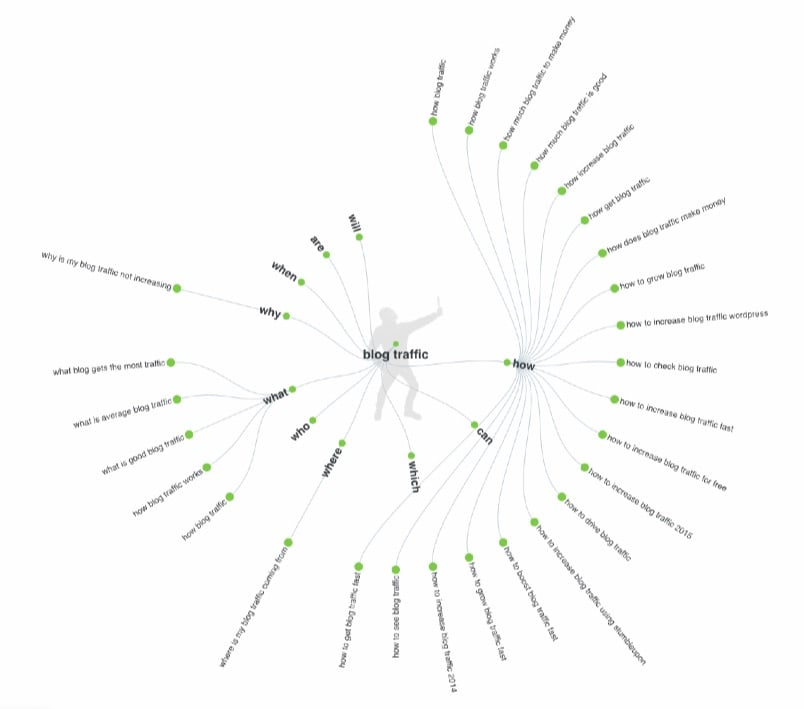
It tells you a lot of the questions being asked on this topic. Questions like:
- Why is my blog traffic not increasing?
- How to get blog traffic fast?
- How much blog traffic is good?
- How to increase blog traffic for free?
This is all great fodder for answers in your content.
Blog Directories
Meh. These things are a relic from years ago and I honestly wouldn’t spend any time submitting your blog to directories.
There used to be SEO benefits to it. But, not much anymore. Don’t waste your time.
Press Releases
I remember the days where this was a thing. People would use various services to publish press releases which contains a backlink to your blog. The goal was SEO and backlinks.
Used to work. Not anymore, though. As usual, the marketers and spammers ruined it.
If something you’re doing is genuinely newsworthy, then sure – issue a press release. But, the notion that you’re going to get search traffic and backlinks from it is a lost cause at this point.
Social Media / Forums
So, this is an interesting one. Because it is rather counter-intuitive.
[clickToTweet tweet=”Most bloggers almost default to social media as a way to build traffic. Thing is, unless you’re paying to boost posts and setting up ads, you’re probably not going to get anywhere.” quote=”Most bloggers almost default to social media as a way to build traffic. Thing is, unless you’re paying to boost posts and setting up ads, you’re probably not going to get anywhere.”]
The cold, hard truth is that social media accounts are more of an amplification device for an existing community than they are a traffic building mechanism. And amplifying zero is still zero, last I checked. 😉
You can get some traffic from social, but considering the amount of time it takes to make it happen, it is just really inefficient. Plus, in terms of actual revenue, your social media accounts are FAR less effective than your email list. OptinMonster gave an overview of email marketing stats vs social media stats and it clearly shows emails wins the race quite substantially.
- 66% made a purchase as a result of email, as opposed to 20% for Facebook and only 6% for Twitter.
- 7% acquired customers from email, and it was less than 1% from Facebook
- 79% reach by email, while 1-6% on Facebook
I think it is safe to say that the only efficient way to make use of social media is if you’re paying for it – and be using it to build your list. To spend much effort on building up your social followings is to play in the sandbox of other bloggers who get nowhere.
Answering questions in forums is the same way. It can lead to some trickles of traffic, but it takes a lot of time to do it.
If you’re starting from scratch or are still under, say, 1,000 email subscribers, then I wouldn’t spend too much time doing exclusively organic social media. You need to be thinking about higher leverage strategies first.
Obviously, have your social profiles set up. And you should be posting there. But, it should be a small minority of your time. In fact, you can even automate it using tools like MeetEdgar. And you might even dedicate a few minutes (and not more than that) per day answering people who speak to you on social. In other words, don’t ignore the channels. However, to spend much time on it is a mistaken priority.
My only interest in social media would be by way of PAID distribution through Facebook ads, Facebook boosted posts into competing audiences, Twitter ads targeting competitor accounts, etc.
Infographics
Back when infographics were more of a novel thing, merely having one would mean extra traffic. Today, not so much. They can still be effective, however they don’t have the punch they used to.
When it makes sense, I would explore using some infographics to go along with some of your big mega-posts which are otherwise leveraged to the max. This infographic will then serve as a viral magnifier for the post.
Using something like Social Warfare, you can even set a specific image for people to share on Pinterest. Set this to your infographic since those kinds of things tend to perform better on Pinterest.
If you don’t have an actual infographic, you could perhaps create a kind of “pseudo infographic” that is still Pinterest-friendly. For instance, I’m going to create one for this very post which will feature the post’s preview image along with the outline of this post.
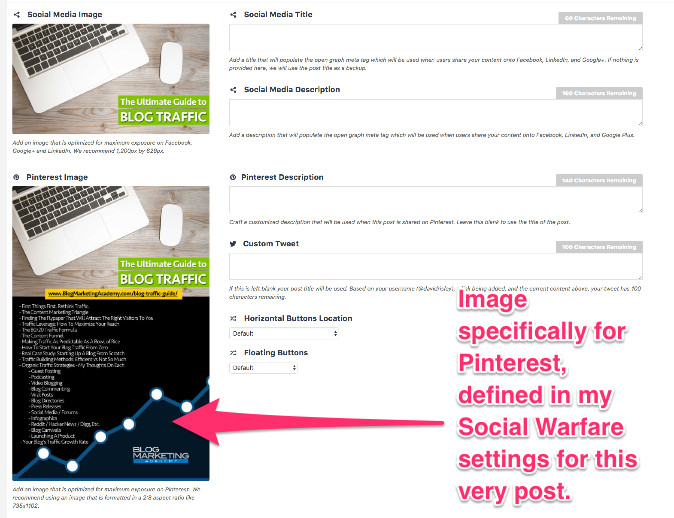
On very visual mediums like Pinterest, this post will show up nicely. And Pinterest can result in some really nice traffic numbers.
Reddit / Hacker News / Digg, Etc.
Social bookmarking used to be a big thing. And even today, if you manage to go viral on these networks, you can get one massive traffic spike. But, it is quite difficult to get onto the front page of these sites and usually involves a lot of behind-the-scenes legwork to make it happen.
Verdict: It isn’t worth it. It won’t hurt anything to post your stuff there. And, hey, you never know. But, don’t have high expectations. Unless you can automate it, I’d forget about it.
Blog Carnivals
A blog carnival is a cross-promotional effort between bloggers. The host of of the carnival announces a blog carnival. It could be based around a giveaway offer or perhaps some topic. The host blog writes the main post which serves as the hub for it. Then, a bunch of other bloggers who wish to participate write their own posts then link back to the original. The original post then links out to the individual blogs which are participating. So, it creates a big link wheel where a bunch of blogs are linking to each other.
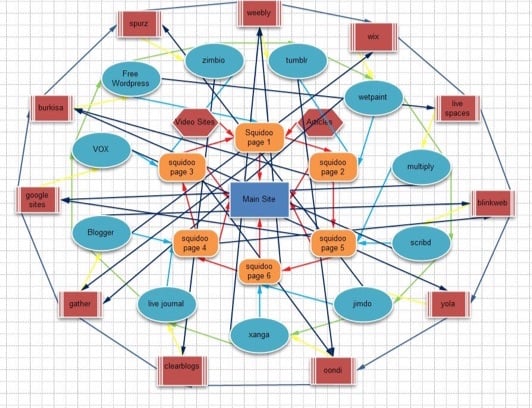
The problem with blog carnivals is that it can be a bit incestuous because a lot of people participate not for the purpose of providing value, but instead just getting traffic. The quality standards are weak and people are just trying to get traffic. In other words, most blog carnivals turn into a spammy linkfest.
And Google doesn’t like spammy links. This means link carnivals could actually hurt your blog.
My verdict: Carnivals can be a little community thing between bloggers and can provide a traffic spike. But, it is a meaningless traffic spike. And, generally, I wouldn’t participate.
Launching A Product
This is a completely different way to build traffic, but it can work in some situations. In fact, this is how I personally got started in the online marketing niche. (You can read my backstory here.)
Now, to be clear, I wasn’t new to the business when I entered the online marketing niche. I had spent 10 years building and growing my own online business in the technology niche by the time I got to actually talking about business online. But, in 2008, I decided to get into this market. And one of the very first things I did was launch a full-on training product and launch it with affiliates. Being that I had networked with some other bloggers at conferences, they knew who I was and some of them participated as an affiliate.
So, I had a bunch of people out there with audiences talking about me. Not only did I make money doing it (it ended up being about an $80,000 launch), but I was firmly on the radar and I had a good audience in place.
Doing a launch can have a lot of impact beyond revenue. Jeff Walker (creator of Product Launch Formula) refers to it as the launch echo. There are a lot of reverberating effects that are non-financial that can come out of a launch – and traffic and awareness if one of them.
Will this work for anybody? No. But, if you can really bring the goods, it is an effective way to go.
Your Blog Traffic Growth Rate: Is It Enough?
One of the questions I’ve gotten is about the rate of growth of blog traffic. What’s good and what’s not?
Truth is, there is no benchmark by which you should judge your blog. The only benchmark that would mean anything would be your own blog. In other words, is it growing? How is it performing compared to itself previously?
The way to really jumpstart the growth of your blog traffic is to apply the proper traffic strategies for the correct phase of your blog. And, of course, to concentrate on that leverage.
Most bloggers feel as if their traffic has stagnated, but that’s almost always because they’re doing the same thing over and over and expecting different results. The usual hamster wheel of writing another blog post, sharing it on your social channels, then repeating… that’s just a hamster wheel.
And when you’re on the hamster wheel, you look for exits. And that’s when bloggers start looking for traffic tactics and shortcuts.
Forget about all that complexity. Instead, concentrate on a few things:
- Slow down your blogging and instead focus on redwood posts.
- Optimize each redwood post to build the 3 main sources of leverage: (1) your email list, (2) retargeting audience, (3) viral promotion.
- Go for high leverage growth strategies, which include paid traffic to your redwood posts.
- Now that you’re spending less time blogging, apply that remaining time to actually building your business.
I tell you one thing…
After 20 years (and counting) of experience as a blogger, this is a completely different way of looking at blog-based marketing than when I started. I came from the background of high-volume blogging, where all my traffic building was relying on free, organic means.
But, things change. The internet grew up. Now, we have to play the game differently.
Got A Question? Need Some Assistance?
Have a question about this article? Need some help with this topic (or anything else)? Send it in and I’ll get back to you personally. If you’re OK with it, I might even use it as the basis of future content so I can make this site most useful.



